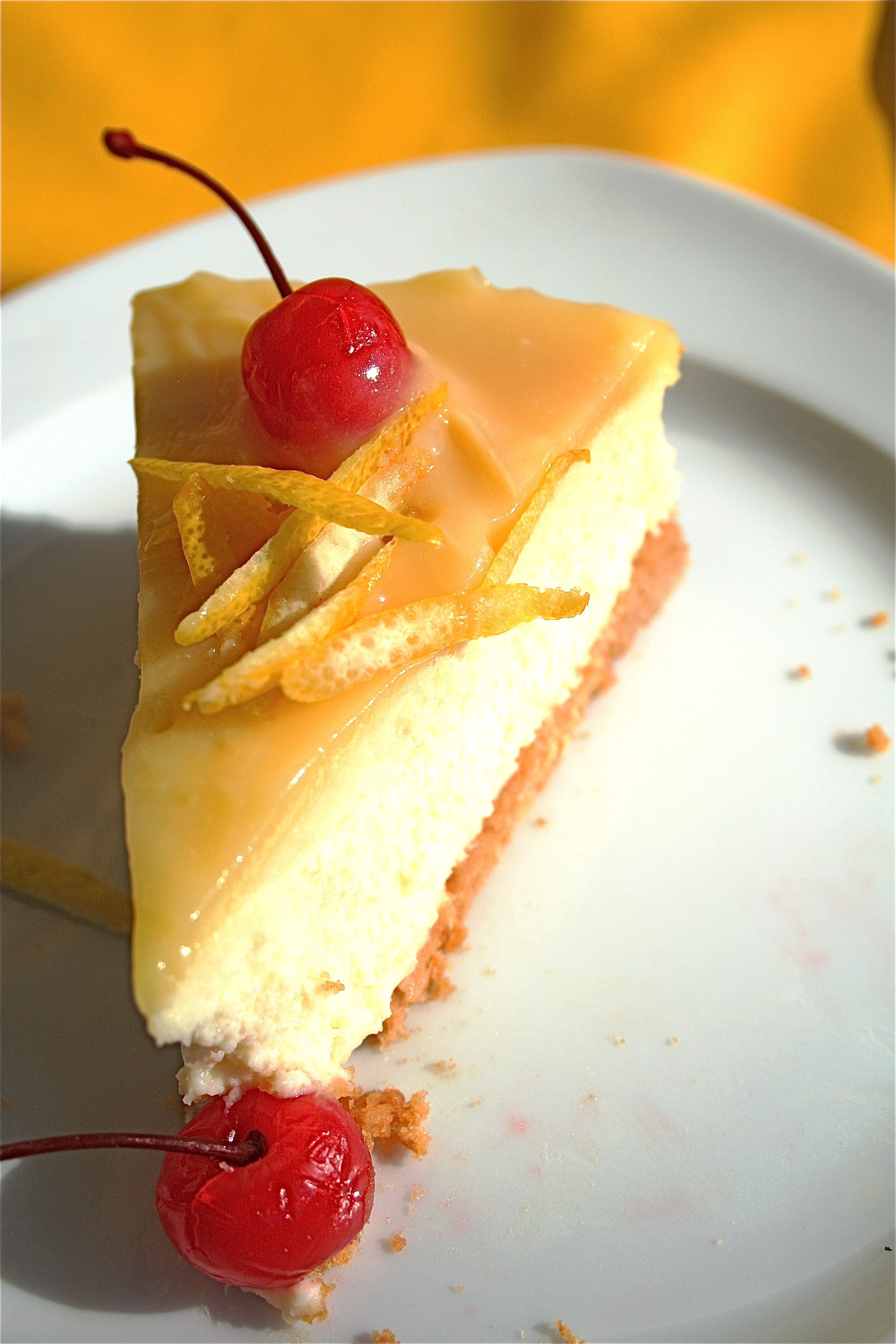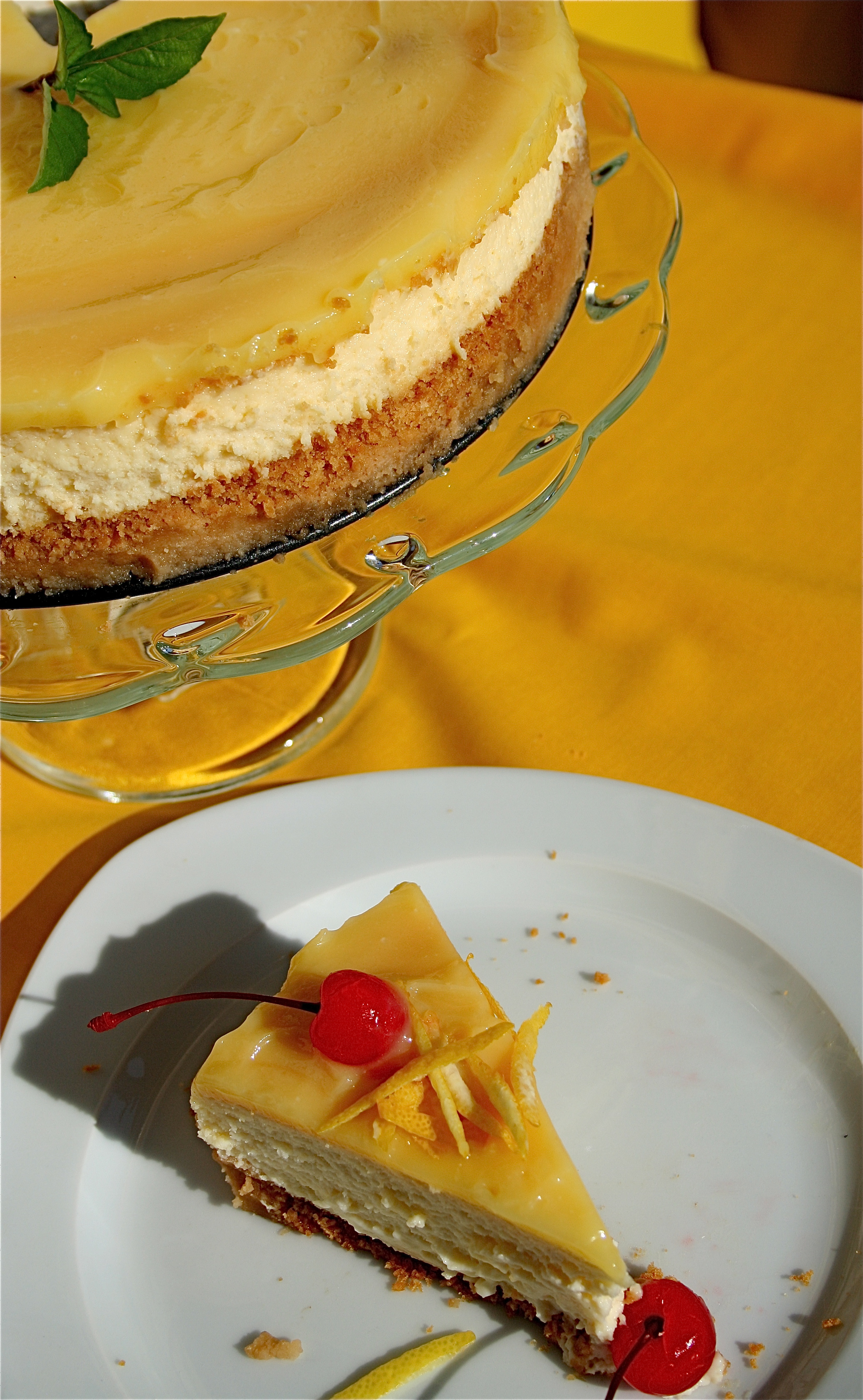
Let me introduce you to a little slice of Heaven. His name is Lemon Cheesecake, and you might fall in love with him.
I was craving something decadent (and definitely NOT healthy), but since it’s summer, I didn’t want to go really heavy and rich (well, today, that is….). I also wanted to make something that presented itself as somewhat of a challenge for me, because the last time I made cheesecake from scratch, it was only partially edible. The idea of making a lemon curd intimidated me, but I have to admit that I was really shocked by how simple this recipe was. The only downside is that you have to let the cake sit and cool and then refrigerate it for at least 5 hours, so if you are in the mood for instant gratification, this is not the dessert to make.
I was also in the mood to celebrate the first couple of weeks on this little blog which is apparently growing quickly. I’m having a blast, and I am so thankful to those friends (new and old) who have been so supportive!
Enough with the small talk-let’s get on with it:
Lemon Cheesecake
Serves: 12 to 16
Cookie Crumb Crust:
5 ounces Nabisco’s Barnum’s Animals Crackers or Social Tea Biscuits (about 80 crackers)
3 tablespoons sugar
4 tablespoons (1/2 stick) unsalted butter, melted and kept warm
Filling:
1 1/4 cups sugar
1 tablespoon grated zest plus 1/4 cup juice from 1 or 2 lemons
1 1/2 pounds (three 8-oz packages) cream cheese, cut into rough 1-inch chunks, at room temperature
4 large eggs, at room temperature
2 teaspoons vanilla extract
1/4 teaspoon salt
1/2 cup heavy cream
Lemon Curd:
1/3 cup juice from 2 lemons
2 large eggs plus 1 large egg yolk
1/2 cup sugar
2 tablespoons cold unsalted butter, cut into 1/2-inch cubes
1 tablespoon heavy cream
1/4 teaspoon vanilla extract
Pinch salt
For the crust:
1. Adjust an oven rack to the lower-middle position and heat the oven to 325 degrees. In a food processor, process the cookies to fine, even crumbs, about 30 seconds (you should have about 1 cup). Add the sugar and pulse 2 or 3 times to incorporate. Add the warm melted butter in a slow, steady stream while pulsing; pulse until the mixture is evenly moistened and resembles wet sand, about ten 1-second pulses. Transfer the mixture to a 9-inch springform pan and press evenly into the pan bottom. Bake until fragrant and golden brown, 15 to 18 minutes. Cool on a wire rack to room temperature, about 30 minutes. When cool, wrap the outside of the pan with two 18-inch-square pieces of heavy-duty foil; set the springform pan in a roasting pan.
For the filling:
2. While the crust is cooling, process 1/4 cup of the sugar and the lemon zest in a food processor until the sugar is yellow and the zest is broken down, about 15 seconds, scraping down the bowl if necessary. Transfer the lemon sugar to a small bowl; stir in the remaining 1 cup sugar.
3. In the bowl of a standing mixer set at low speed, beat the cream cheese to break it up and soften it slightly, about 5 seconds. With the machine running, add the sugar mixture in a slow steady stream; increase the speed to medium and continue to beat until the mixture is creamy and smooth, scraping the sides and bottom of the bowl well after each addition. Reduce the speed to medium-low and add the eggs, 2 at a time; beat until incorporated, about 30 seconds, scraping down the sides of the bowl well after each addition. Add the lemon juice, vanilla, and salt and mix until just incorporated, about 5 seconds; add the heavy cream and mix until just incorporated, about 5 seconds longer. Give the batter a final scrape, stir with a rubber spatula, and pour into the prepared springform pan; fill the roasting pan with enough hot tap water to come halfway up the sides of the springform pan. Bake until the center jiggles slightly, the sides just start to puff, the surface is no longer shiny, and an instant-read thermometer inserted in the center of the cake reads 150 degrees, 55 to 60 minutes. Turn off the oven and prop open the oven door with a potholder to wooden spoon handle; allow the cake to cool in the water bath in the oven for 1 hour. Transfer the springform pan without foil to a wire rack; run a small paring knife around the inside edge of the pan to loosen the sides of the cake and cool the cake to room temperature, about 2 hours.
For the lemon curd:
4. While the cheesecake bakes, heat the lemon juice in a small non-reactive saucepan over medium heat until hot but not boiling. Whisk the eggs and yolk in a medium non-reactive bowl; gradually whisk in the sugar. Whisking constantly, slowly pour the hot lemon juice into the eggs, then return the mixture to the saucepan and cook over medium heat, stirring constantly with a wooden spoon, until the mixture measures 170 degrees on an instant-read thermometer and is thick enough to cling to the spoon, about 3 minutes. Immediately remove the pan from the heat and stir in the cold butter until incorporated; stir in the cream, vanilla, and salt, then pour the curd through a fine-mesh strainer into a small non-reactive bowl. Cover the surface of the curd directly with plastic wrap; refrigerate until needed.
To finish the cake:
5. When the cheesecake is cool, scrape the lemon curd onto the cheesecake still in the springform pan; using an offset icing spatula, spread the curd evenly over the top of the cheesecake. Cover tightly with plastic wrap and refrigerate for at least 5 hours or up to 24 hours. To serve, remove the sides of the springform pan and cut the cake into wedges.
The cake can be refrigerated for up to 4 days.
Adapted from Baking Illustrated.









Kellie - This looks really, really good. Thanks for posting!